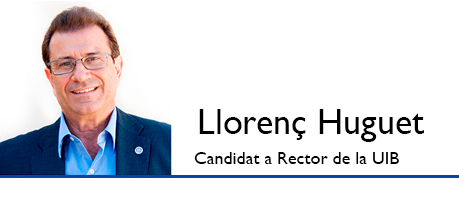Aquests dies he tengut el privilegi de viure una campanya electoral en primera persona acompanyant a Llorenç Huguet. He après molt. He vist la meva universitat des d’una altra perspectiva. He tengut el plaer de conèixer gent que estima la UIB encara més que jo. Persones que estan disposades a ajudar a la nostra universitat a sortir del lloc on l’ha col·locada una política de retallades les conseqüències de la qual pagarem molts d’anys.
“Perquè n’Huguet?” m’ha demanat molta gent. La resposta, òbviament, es troba al programa que hem dissenyat entre tots els membres de l’equip den Llorenç. Un programa que no es tancarà fins dia 20 de maig perquè des del principi l’hem volgut fer comptant amb la participació de tota la comunitat universitària.
Però hi ha motius que no són al programa de forma explícita. Dimecres dia 22 hem de votar a n’Huguet els que volem un rector amb experiència per començar a treballar dia 23. També els que volem un rector que tengui il·lusió per ser-ho i que faci que molts de nosaltres recuperem aquesta il·lusió facilitant-nos les coses. L’hem de votar els que creiem en una universitat pública de tots i per a tots.
Clar que s’ha de repensar la universitat i s’ha de mirar al futur! Però això no es pot fer si els papers s’acumulen al teu voltant, si has d’impartir classes a grups d’alumnes enormes, si no hi ha un equip rectoral que sàpiga gestionar la universitat per tal que cadascú faci allò que ha de fer. Quan el professorat torni a parlar de fer classes en lloc de fer cronogrames, quan l’alumnat torni a parlar del que li han ensenyat en lloc de lo complicat que és canviar-se de grup de pràctiques, i quan el personal d’administració i serveis torni a veure perquè serveix la feinada que fa, quan algú es preocupi de canviar tot això, podrem repensar la UIB amb garanties d’èxit.
Hem de votar a un rector proper que confiï en les persones i no en els sistemes d’avaluació/control. Un rector que vulgui mantenir l’excel·lència en la investigació i al mateix temps que tothom que vulgui en pugui fer. Un rector que desburocratitzi Bolonya. Un rector que es preocupi personalment de la internacionalització, però ben assessorat per un grup de gent que fa molts d’anys que treballa en aquest camp. Un rector que es comprometi personalment amb el català i no només perquè així ho diuen els estatuts. Un rector que ajudi a formar persones per tal que arribin a ser els “perfils” que necessitem i no al revés.
Tenim persones a la UIB que volen treballar juntes per construir. Cal una persona que les valori, les hi doni confiança i les lideri … i tenim una persona que té la voluntat i la capacitat de fer-ho: Llorenç Huguet.

